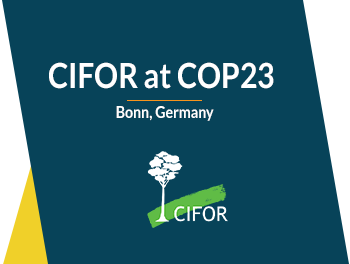One woman described the centuries-old, female-centered production of argan oil in Morocco and the recent degradation of the country’s forests. Another spoke of the gender disparities in experiences at REDD+ sites. And yet another talked of women in eastern India who cultivate up to 60 different crops in one shifting cultivation cycle, working from a base of rich traditional wisdom.
At the Center for International Forestry Research (CIFOR) session “Gender equality, rights and ancestral knowledge in the context of forest landscape restoration” on the sidelines of COP23, a diverse set of panelists stood at a frontier – bringing gender equality and women’s rights to the forest landscape restoration (FLR) conversation.
With international commitments to restoring forests and landscapes now almost de rigueur, there is a need to ensure gender considerations are incorporated from the start, lest inequalities be perpetuated, women excluded or rights wrested away.
On a gray morning in Bonn, a majority-female set of speakers – refreshing amid the number of all-male panels at COP23 – proffered insights ranging from the importance of community forests for women’s rights to the need for active and informed female participation in decision-making and the necessity that all of us confront our unseen biases.
Forest rights advocate Madhu Sarin talked of her experiences with forests and communities in India, and the trial-and-error process of reconciling top-down processes with moves toward equality for women in some forested areas, all while interrogating assumptions about rights.
“It’s only movements that can lead to transformative change. Community people working on the ground. The problem is that grassroots movements are like a drop in the ocean. We don’t have so many movements and we don’t have widespread movements – they are in certain pockets, but not all over. And not all movements are gender sensitive,” she said.
SHIFTING PARADIGMS
But clearly lack of gender sensitivity is not only a developing world problem.
Panelist Nigel Crawhall of UNESCO talked of the need to harmonize forms of knowledge, bringing local, indigenous, Western and other kinds of understandings together when thinking about forests and restoration, and the need to bring real interactions to the table amid issues of race, power, gender and identity. And, that table may already be steeped in a bias we may not recognize.
“[You] have to ask questions about the cultural framework in which you’re working … If there’s already a gender bias in the Western science framework, that’s what you’re bringing indigenous people into … You must shape the platform so you create a safer, more inclusive space so different paradigms can be in that space together,” he said.
For panelist Lorena Aguilar of IUCN, participation in FLR needs to be inclusive and built on a strong knowledge base with everyone, including indigenous women, informed and aware. “It’s not about applying a standard, like saying indigenous people need to participate. REDD is not a color, and FLR is not a powder you put in the water.”
Many of the panelists addressed this concern – that international commitments just may neglect the perspectives of communities who will then live in the midst of land others demarcate for restoration.
Moderator Markus Ihalainen of CIFOR said in a later interview, “A key aspect of FLR is bringing stakeholders together to voice issues or concerns and to negotiate compromises, but not all stakeholders are equally powerful and not all voices are equally heard.”
